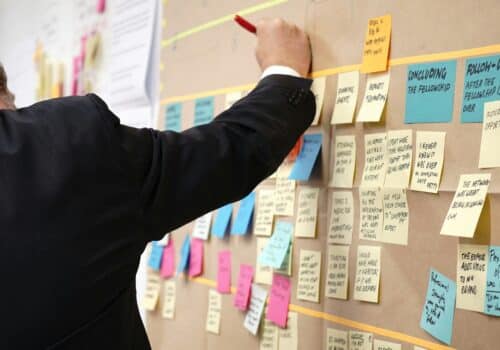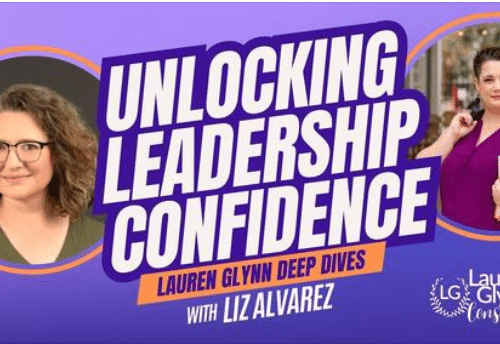September Connections video: Deep dive into ERP planning (and our framework)
September is the time to start planning for big change initiatives in the new year. When companies start gearing up for ERP projects right about now, they often focus solely on the cost and time required to do the implementation itself — without realizing there are a lot of other things that need to happen up front to make sure their organization is ready.
That’s why our first order of business with our clients is to think through the people, processes, and technology they need for a successful implementation — before they even start to lay out requirements for ERP solution selection.
If ERP is on your radar for next year, you should start your planning no later than this fall, and we have a powerfully effective framework you can use to do it.
This month’s video is a deep dive into the planning process and the framework we use to guide our clients as they prepare for ERP projects. The video is longer than our usual 3-5 minutes, but it’s packed full of important information you’re going to want to know and think about.
Want more help figuring out what you’ll need for a successful ERP implementation? Download our ERP Readiness Assessment, which will give you a structured framework for thinking through the 4 phases of implementation and understanding the resources you need at each stage. And in case it’s helpful, here’s a link to the slides I shared in the video.
Watch the video:
Hi there! Erin Koss, CEO at Syte Consulting Group with you here today. It’s time. Indeed, it is. It is 2023 planning season, and our clients are starting to ask us about the big initiatives they have on the agenda for next year.
They asking questions like: “How much do they cost?” and “How much time will they take?” Today, I want to talk a little bit about what that looks like when it comes to ERP for manufacturing companies. Our family-owned manufacturing clients spend a good part of the fall planning for these large initiatives next year. When ERP is on the table, we have conversations with them about how to think about that.
Many times, what happens is the focus is on the cost and time required to do just the implementation. The reality of it is, there’s a lot of things that must happen upfront to make sure you’re ready for that big, important change initiative. Today, I wanted to share some resources with you if you’re putting ERP into your budget and planning for next year and some of the things you want to think about when you’re doing that. I’m excited to share some resources with you that I think will help guide that conversation. We’ll also make sure that we share these resources with you in the notes that we provide today with the video.
I wanted to just start by saying there’s a framework for this that we think about if you’re looking at implementation possibly next year. The reality of it is you need to think about the people, the processes. and the technology that are going to be necessary when you get to that place. There’s a lot of planning that goes into that so let’s talk about that a little bit today. When we talk about getting to implementation success, we talk about three things that must happen.
First, measuring at a strategic level, assessing at a more tactical level, and then selecting a solution that is going to be the right fit for your business. All of these phases build on one another to get you to the implementation starting gate in the most effective way. Truthfully, this includes the most cost-effective way as well. One of the things we see is companies jump right to the implementation phase. When you skip these other phases, you end up paying for it when you get here in the form of delayed timelines and additional costs. We also like to talk about the fact that there can be a real significant wear and tear on your people when the delays happen as well. Remember, these are big, big projects.
Implementation takes a lot of time and effort, and when you burn people out just getting there, it can be painful. We try and follow a structured framework and share this with our clients so that they can get to the implementation starting date most efficiently. When we talk about measuring, we’re talking about a strategic process of looking at what you have at a strategic level in terms of readiness. Does the executive team understand the effort they’re taking on and how much it’s going to take in terms of people? It’s a people, process, and technology conversation at this point.
But the biggest thing we talk about here is people. Do you have the capacity and the capabilities to take on what it is you’re getting ready to take on? We ask this because it can really impact your budget if in fact you don’t have the people you need in-house. You may need to hire an additional business analyst. You may need to hire outside consulting to do project management. Do the analysis and technical work that maybe you’re not ready to do? We have a lot of conversations strategically with the executive team at this point about how to think about their people.
Then, we move into processing technology as we go. I want to share a couple of resources with you here that might be helpful. These resources are how to think about the types of resources you might need and how to choose them. We talk about whether you need to backfill or whether you need to outsource or maybe higher. This has a lot to do with how your company is structured today and what your goals are in the future. We’ll share this important resource with you as a way to think about which resources you might need. But we do talk a lot about the idea of outsourcing being a good play, when in fact they are resources you may not need long-term.
Usually, we find that there is the need to hire one or two resources that you probably don’t have today. It might be on the technical side but more than likely, it’s probably on the analyst side. This is where you’re going to need to do some things in the future that you don’t need to necessarily do now when you take on a new ERP solution.
You’re going to have the tools you need for more analysis and more business intelligence tools and opportunities as well. This is a different kind of person than you might have today in both in terms of capacity and capability. I do encourage you to read through these slides, particularly starting here, and then moving into the capabilities and capacity requirements. One of the things we like to do is help our executives understand what roles are going to be necessary for implementation. It’s not insignificant.
We talk here in this slide about what roles are needed and what capabilities do they need to have. How much time do they need? During implementation, do they tend to be internal or external? I encourage you to sit down with your executive team and other leaders to look at this and think about what you might need in terms of capabilities and capacity relative to what you have today. This is some more detail that might help you with that conversation. Lastly, this is a slide that we like to share with our clients, which is helping them through the actual gap analysis.
You have this kind of capacity, but you need this kind of capacity. Where are your gaps? It’s a simple exercise for sure and it’s one that oftentimes isn’t looked at thoroughly enough and can really impact the costs that you take on during the implementation. Those are just some resources as you think about at a high-level strategic perspective. Mostly, it’s a people conversation at that point because that’s the thing that’s really going to hold an organization back from even getting started.
Next, we move on to the assessment phase. This starts to get into a tactical conversation of where the business process landscape is n your organization. What do you understand about today’s current processes? How well do they function? Is there a common alignment among what the issues are? What the future requirements might be? We find there typically isn’t.
Companies will jump into selecting an ERP without having set the groundwork or laid the groundwork for the requirements for their business. They will bring in solution partners to do a dog-and-pony show and tell them what they need. The trouble is we find more failed selections and stalled implementations as a result when companies don’t take a formal process for selecting ERP software. You can’t do that if you haven’t assessed where the processes are today, what the issues are around them, and get alignment on what you need in the future. One of the things we do during this step is to gather all the subject matter experts, the people who are experts in your business and have conversations and map out processes for what you have today and identify as we go what do you need for tomorrow.
One of the deliverables that comes out of here tends to be this. Here’s an example of the business process mapping that you might see as a deliverable from this phase. What’s great about this particular exercise is that we love not only the chance to understand what’s happening today (the issues and stage setting for requirements) but you get this lovely alignment cross functionally among people who are part of any key business process, like procure to pay, order to cash, and manufacturing. You start bringing those folks together who you think might have a common understanding up and downstream of the work that they do and rely on one another for. We often find that they just don’t. They’re so busy doing their day jobs.
They rarely take the time to recognize fully what’s going on up and downstream and it gives people a fresh perspective. It also sets the stage for selection and implementation. When you get to the implementation phase, the information gathered during the assess phase is so important because when the solution providers come in and start asking you questions about how about this and how about that, how do you do this? What do you want?
We’ve already got it all documented and queued up and most importantly, your people have had these conversations already. They’re not being blindsided by it. They know it’s coming. Everybody’s already been talking about it. We’re queued up for implementation success based on the time we took during the assessment timeframe to document the business processes, the issues and the requirements.
One of the other things we talk about during the assess phase is technology. These are some of the components that we talk about during the technology readiness. I’ve created a link here that will send you out to our ERP readiness assessment where this Q and A is in more detail, as well as some other conversations that we’ve talked about already surrounding people and process. A little deeper dive can be found in the ERP assessment. But I want to just give you a snapshot here of during the assess phase. You want to be looking at where your technology
hardware, disaster recovery, et cetera is. Today, where is it you think it’s going? Tomorrow, is it moving to the cloud? What kind of resources will have to change because of the changes in platform for you?
Next, we get to the select phase. You’ve laid the groundwork. You know what you’re going to need for people. You understand your technology and environment. You understand where your business processes are and where your gaps are in all of those areas. You understand your requirements set a little bit better.
Now you’re ready to do a deep dive on those requirements. What are your vendor requirements? What are your technology requirements? What are your functional requirements?
Again, that stage has been set and we put a fine point on them during this phase. We start looking at solution partners for implementation. This is that process whereby you take control of the solution that you choose because it’s driven by your requirements. Again, it’s not driven by the dog and pony show of solution providers that, of course, are biased toward their own product. We guide you through that process to get you to the other side where you have a selection of a solution that is meant for you and your business.
Finally, the implementation stage has been set, the solution has been selected, and now you’re looking at the real work and the real budget effort. You come out of selection and the selection will drive the numbers for implementation. We’re setting the stage for it as we go. We’re getting some high-level numbers as we go in the measure and assess and select phase. But when we come out of select, we are at that point that we will have the hard numbers needed for implementation.
Now, the good news is if you’re going into the planning cycle for 2023 and you haven’t gone through the first three phases, we’ve done plenty of times where we can help you estimate what it would take to implement a particular solution or a solution for a company of your size. We can get those numbers in place for you so that you’ve got them for planning purposes.
Lastly, I want to share this slide because this is a question we get often from our clients. How much time should I plan? Like I said, the time that you spend in measuring assessments and selecting will be time saved in the implementation phase. We’ve seen companies jump right to implementation and their implementation stalls out for as much as two years before they need to backpedal. Worst case, they must select new software.
Best case, they go back and do some of these early steps to set the stage for proper implementation planning. This is costly and time consuming. Not to mention, it’s really demoralizing for a core team who is working hard and is geared up to implement. I just wanted to share this in a timeframe you can expect over here. Here’s some of the expectations from your team and just the estimated number of hours required by possibly our team as well. There you have it: all four phases of a successful framework for getting to implementation.
If you’re planning for and trying to budget for 2023, we really encourage you to follow a structured framework to get you there from a process perspective. Make sure you’re looking at your people, your process, and technology in graduating steps as you move through a framework like this. Ultimately, you’ll get to a place where not only are you set up for implementation success. In the end, you’ll also have the costs and an understanding of the capacity and capabilities that you need going into the next year so your budget will be ready to go as well. If we can help you at all in this process, we would certainly love to.
Feel free to reach out anytime and give me a call. My contact information will be in the notes. Have a great day and take care!
ERP Readiness Self-Assessment
Is your organization ready for a new or upgraded ERP solution? Find out with this complimentary self-assessment.
Doing Business Better
You strive for excellence, believe in your people, and want to do things right the first time. And you know that you need help to get to the heart of your business challenges and make the best choices for the future of your privately held manufacturing and distribution company. That’s where we come in.
We help you focus and find exactly the right path to accelerated growth and sustainable success — from your people to your processes to your ERP software.



